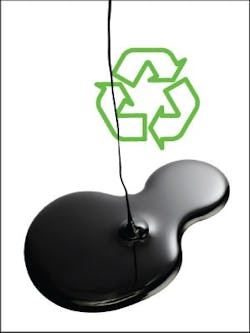Auto repair shops generate a significant amount of waste products through daily operations—items that can have tremendous negative environmental impact if not disposed of properly, says Mike Torres, owner of Dakota Ridge Complete Automotive in Littleton, Colo. Every shop operator should do their part to correctly deal with shop waste by recycling and reusing to the benefit of your environment, community and business.
One item that can be particularly harmful if not dealt with the right way is waste fluid. Torres, an avid recycler who has developed best practices for disposing of just about every material in his shop, outlines his process for recycling vehicle fluids, and how you can even make a little extra cash through the effort.
Implementing a diligent recycling process is a smart way to operate. Leaving the smallest possible carbon footprint is the right thing to do, and it’s a great value proposition to market to customers. That’s why recycling is a foundational value of our company. On top of that, most recycling efforts are free, and some actually generate money for the shop.
Our recycling efforts are focused on every product used throughout the facility, but one area we have invested a lot of time in is recycling fluids.
We recycle several types of fluids from vehicles, including engine oil, transfer case fluid, differential oil, brake fluid, washer fluid, transmission fluid, gear oil, power steering fluid and brake cleaner.
Those fluids are mixed together in one bulk oil collection tank. We have an agreement with our local oil pickup company and they collect the fluids from the tank once every two weeks to refine and reuse as waste-oil heat.
We get paid an average of 50 cents per gallon for those vehicle fluids. We collect roughly 600–800 gallons of fluids every month, which equals about $300–400 of monthly reimbursement.
The company you buy oil products from should be able to guide you to a collection company, if they don’t collect it themselves. Our oil company, for example, does not collect waste oil, so they guided us to a company that did.
We had to purchase the collection tank ourselves. We purchased that independently from Rhino Tanks and we own it. There are safety standards in terms of the tank used. It must have self-containment abilities to hold flammable oil. That means that for a 400-gallon tank like ours, it has to have 200 gallons of secondary containment. They have tanks ranging from 55 gallons up to 600 gallons, so you can really find the correct size for your shop.
To transfer the oil from the shop to the collection tank, we have three roll-around tanks that hold roughly 30 gallons each inside the shop. We roll those around to each car, and the oil drains directly out of the vehicle into the collection bucket on top. There is a sight gauge on the tank and when we see it is nearly full, we roll the small tank out to the collection tank. There, we have an air hose set up and air pumps the oil from the 30-gallon tank into the collection tank. We have to do that about once a day and it takes five minutes.
The only fluid we have to separate is antifreeze. We separate antifreeze from the rest of the vehicle fluids into a separate tank, which is picked up by a company that sells recycled antifreeze. The same company that takes our waste oil also takes our antifreeze. We have a 100-gallon tank to collect the antifreeze. We chose that size because we found that we used 100 gallons of antifreeze in the same amount of time it took us to go through 400 gallons of oil. There is no charge to have the material taken off site and we don’t get paid for it.
Shops that aren’t putting in the effort to recycle are missing the boat. It drives several benefits including moral, environmental, financial and marketing perspectives. And we’re not working much harder to do the right thing. I found that working with the local oil supplier was a huge resource in getting this set up. They have worked with hundreds of shops, so they were able to help me with getting the right type of tanks and storage. Now, we’re only spending a matter of minutes to conduct these processes.



